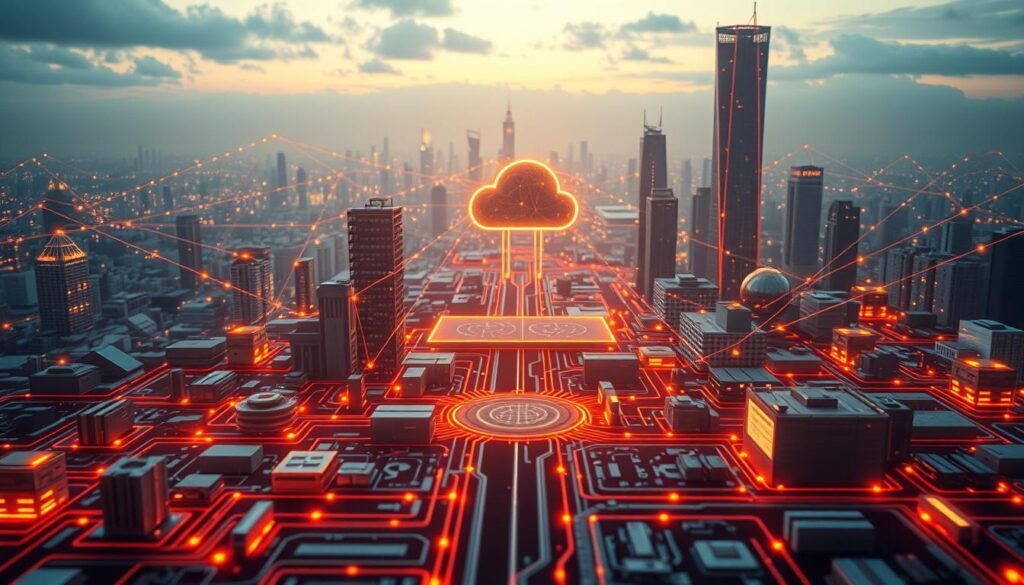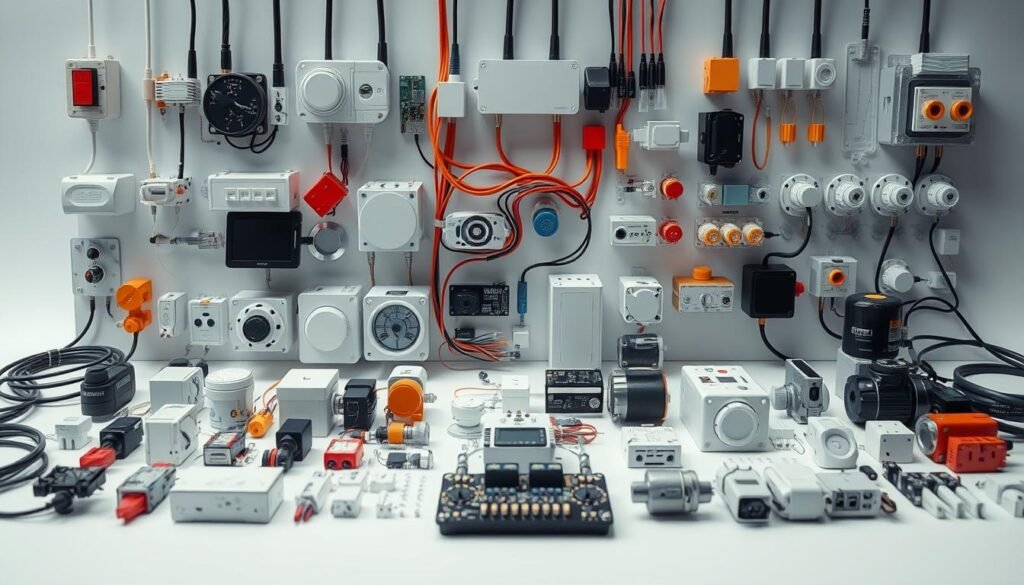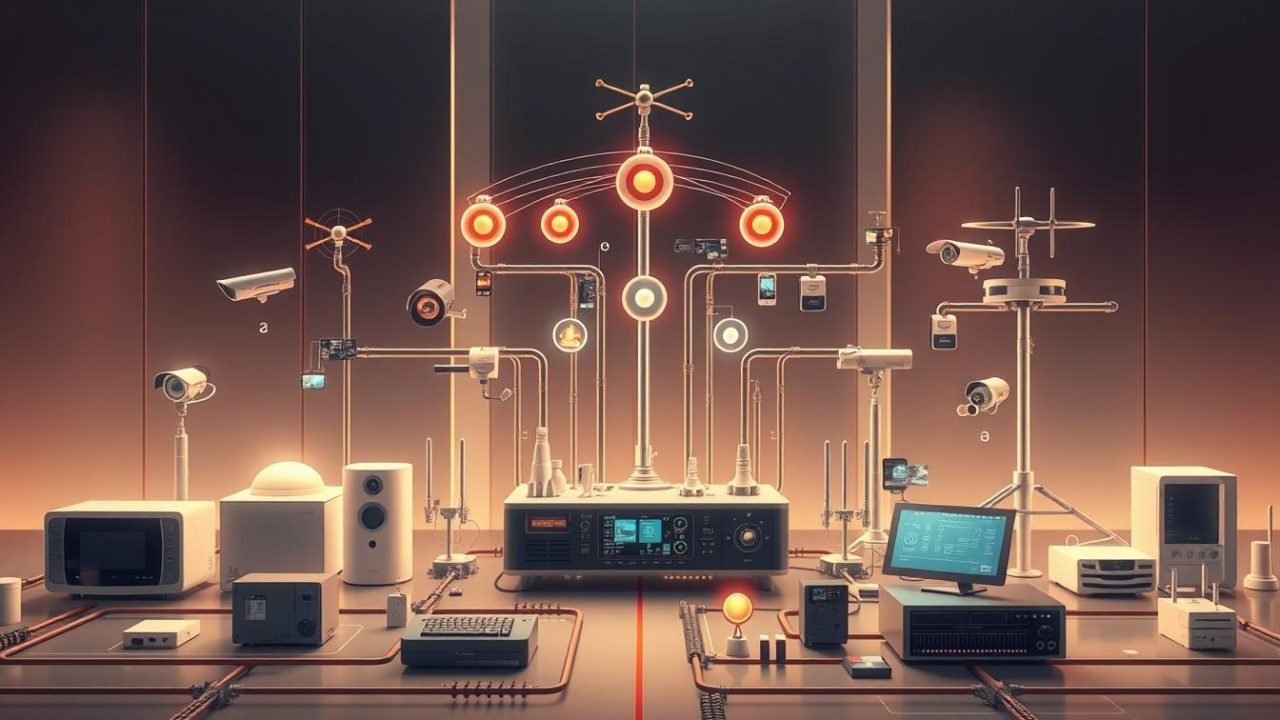The Internet of Things (IoT) is a new tech world. It links devices, sensors, and networks to make smart systems. We look at the key parts of IoT that drive change in India and worldwide.
An IoT system has many parts that work together well. These parts are key to turning data into useful insights. This helps businesses make better choices and work more efficiently.
To understand IoT, you need to know about the tech that talks, processes, and analyzes data. Each part has its own job in making strong and growing solutions. These solutions tackle big tech problems.
Key Takeaways
- IoT systems integrate multiple technological components
- Connectivity is fundamental to IoT infrastructure
- Data processing enables intelligent decision-making
- Scalability distinguishes advanced IoT architectures
- Security remains a critical consideration in IoT design
Understanding the Fundamentals of IoT Architecture
The Internet of Things (IoT) ensures everything, from basic connected devices to intelligent systems, is joined up. It stokes innovation across a variety of places. Our exploration of IoT architecture reveals a web of intelligent systems that revolutionize our digital tool usage.

It is a set up in which devices and diverse digital systems communicate with one another. IoT is a field where we have made big jumps in technology and with these jumps, the need for better communication. This has made IoT more potent and beneficial across various domains.
Tracing the Development of IoT Systems
The journey of IoT systems has been amazing, with many important steps:
- Early devices that could only talk to each other a little
- Advanced sensors that collect more detailed data
- AI and machine learning added for smarter systems
- New network protocols for complex IoT systems
Core Building Blocks of IoT Infrastructure
Good IoT architecture needs key parts to work well together. These parts make systems smart and quick to respond:
- Sensors and Actuators: They pick up and change physical data
- Connectivity Protocols: Ways for devices to talk to each other
- Data Processing Units: They figure out and understand the data
- Cloud Infrastructure: Where data is stored and processed
Understanding Architectural Layers
IoT layers make up a detailed framework for complex interactions and data flow. These layers are:
- Perception Layer: Physical sensors and data collection
- Network Layer: Data transmission and communication
- Processing Layer: Data analysis and interpretation
- Application Layer: Where users interact with the system
Knowing these parts helps us see how IoT systems are so strong and changing today’s tech world.
Sensors and Actuators: The Physical Layer

IoT sensors and actuators are key to the physical layer in Internet of Things systems. They connect digital tech to the real world. This lets smart devices sense and react to their surroundings.
The physical layer is vital. It turns raw data into useful information. IoT sensors pick up data like temperature, humidity, and light levels.
- Temperature sensors
- Proximity sensors
- Pressure sensors
- Motion detection sensors
- Humidity sensors
IoT actuators do the opposite. They turn digital signals into physical actions. They help make systems that can adapt and respond.
| Sensor Type | Primary Function | Common Applications |
|---|---|---|
| Temperature Sensor | Measure ambient temperature | Smart homes, industrial monitoring |
| Motion Sensor | Detect movement | Security systems, automation |
| Pressure Sensor | Measure pressure variations | Industrial equipment, medical devices |
Looking into the physical layer shows how data becomes action. It helps us see how IoT systems make smart, interactive spaces.
Internet of Things: Components and Connectivity
The world of IoT connectivity is a complex network of smart devices. They talk to each other in different places. We see how these devices share information quickly and well.
IoT connectivity changes how devices talk to each other. It makes smart systems that connect the physical and digital worlds. These connections need advanced network protocols and standards.
Network Protocols in IoT Environments
Several key network protocols help IoT devices communicate:
- MQTT (Message Queuing Telemetry Transport): Lightweight protocol ideal for constrained devices
- CoAP (Constrained Application Protocol): Designed for resource-limited networks
- WebSocket: Enables real-time, bidirectional communication
Communication Standards Driving Connectivity
Many communication standards help IoT devices talk to each other:
- Zigbee: Low-power, short-range wireless communication
- LoRaWAN: Long-range, low-power wide-area networking
- NB-IoT: Narrowband IoT for cellular networks
Data Exchange Methods
New ways to exchange data keep IoT networks running smoothly. Efficient data transmission is key for smart and quick systems.
“IoT connectivity transforms raw data into actionable insights, revolutionizing how we understand and interact with technology.” – Tech Innovation Research
Gateway Devices and Edge Computing
IoT gateways are key in linking various devices and managing complex networks. They act as smart middlemen, connecting local IoT devices to the cloud. This makes data sharing and processing smooth.
Edge computing changes how we process data in IoT systems. It moves tasks closer to where data is collected. This cuts down on delays and boosts system performance.
- Minimize network congestion
- Reduce data transmission costs
- Improve real-time decision making
- Enhance device security
Our study shows the benefits of IoT gateways in edge computing:
| Gateway Function | Performance Impact |
|---|---|
| Protocol Translation | Enables communication between heterogeneous devices |
| Local Data Processing | Reduces cloud dependency and speeds up response times |
| Security Filtering | Implements initial threat detection and mitigation |
“Edge computing transforms IoT from simple data collection to intelligent, responsive systems.” – Tech Innovation Journal
Edge computing’s impact is seen in real-world uses across many fields. It makes data processing quicker and more efficient, from smart manufacturing to self-driving cars. IoT gateways are key to this faster, more efficient data handling at the network’s edge.
Cloud Infrastructure in IoT Systems
The heart of today’s Internet of Things (IoT) systems is strong cloud infrastructure. Our digital world needs advanced platforms to handle and store huge amounts of data from connected devices.
Cloud storage has changed how companies deal with IoT data. These platforms offer flexible, safe, and growing spaces for managing complex IoT networks in many fields.
Advanced Cloud Storage Capabilities
IoT cloud infrastructure has top-notch storage solutions for handling huge data amounts. Key features include:
- Real-time data ingestion
- Distributed storage architecture
- Automated backup mechanisms
- Intelligent data compression techniques
Processing Power and Performance
Modern cloud platforms offer great processing power for IoT systems. Distributed computing helps quickly analyze complex data, turning it into useful insights.
Scalability Features
Scalability is key in IoT cloud infrastructure. Our cloud solutions grow with data needs, ensuring smooth expansion without losing performance or reliability.
Companies can use cloud storage to:
- Keep up with growing device networks
- Improve resource use
- Lower costs for maintaining infrastructure
Cloud infrastructure is the future of IoT data management, bringing unmatched flexibility and computing power.
Data Processing and Analytics Frameworks
The world of IoT data analytics has changed how we deal with huge amounts of sensor data. Big data processing is key in handling the complex world of connected devices and their constant data flow.
Machine learning algorithms are now essential for making sense of raw IoT data. These advanced tools help spot patterns and predict future trends in many fields.
- Real-time data streaming and analysis
- Predictive maintenance algorithms
- Intelligent anomaly detection systems
Our strategy for IoT data analytics includes several key steps:
- Setting up scalable data ingestion platforms
- Building advanced machine learning models
- Creating strong visualization dashboards
Big data processing tools like Apache Spark and Hadoop give us the power to handle complex IoT data. These platforms help turn raw sensor data into useful business insights.
The future of IoT is about smart, adaptive analytics that can predict and act on new trends in real-time.
By using the latest in machine learning, we can get deep insights from connected devices. This drives innovation in many areas.
Security Mechanisms and Protocols
IoT security is now a big deal in our connected world. With more devices on networks, keeping data safe and stopping unauthorized access is key. This is a big challenge for tech experts and companies.
IoT systems need strong protection to face many threats. Our security plan covers several important areas:
- Device-level authentication protocols
- Advanced encryption techniques
- Comprehensive threat protection mechanisms
- Continuous network monitoring
Authentication Methods
Authentication is the first defense in IoT security. We suggest using multi-factor authentication. This checks device identities in several ways:
- Unique device credentials
- Biometric verification
- Digital certificate validation
- Token-based access control
Encryption Standards
Data encryption makes information unreadable, stopping unauthorized access. Advanced encryption standards like AES-256 offer top-notch protection for IoT data.
Threat Protection
Good threat protection needs a layered, proactive approach. Our methods include real-time threat detection and automated security updates. We also use smart systems to spot and stop intrusions early.
“Security is not a product, but a process.” – Bruce Schneier
Application Layer and User Interface
The application layer is key in linking complex IoT tech to users. It shows how easy-to-use interfaces turn data into useful insights in many IoT areas.
User interfaces in IoT systems are very important. They make complex tech easy for users to interact with. We aim to create interfaces that make using smart devices and understanding data easy.
- Intuitive dashboard designs
- Real-time data monitoring
- Interactive visualization tools
- Customizable reporting features
Data visualization is a big part of good IoT apps. Strategic visual representations make it easy for users to grasp complex sensor data. This helps in making quick decisions in fields like healthcare, manufacturing, and smart homes.
Effective user interfaces transform complex IoT data into actionable intelligence.
Our study points out important things for making strong IoT app interfaces:
- Simplify complex technological interactions
- Provide clear, comprehensible data representations
- Ensure seamless cross-platform compatibility
- Implement responsive design principles
IoT apps are getting better, needing smarter yet easy-to-use interfaces. These interfaces must connect tech complexity with user-friendly experiences.
Device Management and Control Systems
IoT device management is key for companies wanting to improve their connected systems. We create smart systems for easy control and monitoring of IoT devices. This works across different networks.
Today’s IoT management tools offer full solutions for managing complex tech setups. These systems help companies:
- Keep track of device performance in real-time
- Use remote monitoring
- Keep network settings consistent
- Update systems quickly
Remote Monitoring Capabilities
Remote monitoring has changed how businesses handle their IoT systems. Our advanced tech gives instant insights into device status and performance. This lets companies spot and fix problems early, cutting downtime and keeping systems running smoothly.
Configuration Management
Good configuration management means all IoT devices have the same settings. We use top tools to automate this, cutting down on mistakes. This makes setting up devices faster and supports growing IoT systems.
System Updates
Keeping IoT devices secure and working right is key. Our update systems offer:
- Automatic patch deployment
- Secure firmware updates
- Little to no network disruption
- Full version tracking
With strong IoT management, companies can achieve high efficiency and tech strength.
Integration and APIs
IoT integration is a big challenge in making things work together smoothly. APIs are key in linking different tech platforms. They help IoT devices and systems talk to each other without trouble.
Looking into IoT interoperability, we find important ways to integrate systems well:
- Standardized communication protocols
- Robust API development frameworks
- Flexible data exchange mechanisms
- Scalable architectural approaches
IoT systems are complex and need smart ways to connect. Middleware solutions are strong tools for linking different devices and platforms. They make it possible for data to flow in real-time and for systems to work together.
| Integration Method | Key Characteristics | Performance Impact |
|---|---|---|
| RESTful APIs | Lightweight, Scalable | High Efficiency |
| GraphQL Interfaces | Flexible Data Querying | Optimized Responses |
| WebSocket Protocols | Real-time Communication | Low Latency |
To succeed in IoT integration, you need to understand the challenges of interoperability. Developers must use flexible strategies. These strategies help devices and systems communicate smoothly across different tech environments.
Power Management and Energy Efficiency
Power management is a big challenge in the Internet of Things (IoT) world. With more IoT devices around, finding ways to save energy is key. We look at new ways to make batteries last longer and use less power in IoT networks.
IoT power management uses smart methods to make devices last longer and work better. The main goal is to use less energy without losing performance.
Battery Technologies for IoT Devices
New battery techs have changed what IoT devices can do. Some big improvements include:
- Lithium-polymer batteries that hold more energy
- Solid-state batteries
- Rechargeable cells that use less power
Energy Harvesting Methods
Energy harvesting offers new ways to power IoT devices with different energy sources:
- Using sunlight to make energy
- Power from temperature changes
- Energy from movement
| Energy Harvesting Method | Power Output | Typical Applications |
|---|---|---|
| Solar | 1-10 mW | Outdoor sensors, wearables |
| Thermal | 0.1-5 mW | Industrial monitoring |
| Kinetic | 0.5-2 mW | Fitness trackers |
Power Optimization Techniques
To make batteries last longer, developers use smart power-saving methods:
- Adjusting power use
- Using sleep mode
- Smart scheduling for data sending
By using new battery techs, energy harvesting, and smart power management, we can make IoT systems more sustainable and last longer.
Conclusion
Our look into IoT system components shows a complex and changing tech world. These systems connect in ways that change how we collect, process, and use data. Each part of an IoT solution is key to making strong and smart networks.
The future of IoT looks bright, with new tech pushing what’s possible. New strategies for using IoT are coming up, with better sensors, cloud tech, and smart analytics. This is helping businesses and researchers make big leaps in efficiency and decision-making.
We’re expecting major advancements in IoT, in the areas of improved edge computing, security and energy consumption. IoT systems will become smarter and more adaptive with the help of machine learning and AI. In order to harness the full potential of IoT, experts and companies need to keep up with these changes.
The potential for IoT appears endless going forward. It will transform our perception of data, connectivity, and intelligent systems across a wide variety of fields. As we delve into the world of IoT, it is evident how it is so important to continue learning and evolving in the fast-paced world of tech.


